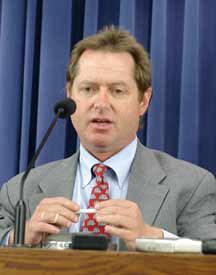Irv Rosenfeld’s appearance at the Illinois medical marijuana hearings has drawn quite a bit of attention and interest. People have been asking me questions about him and the program, so I thought I’d go into more detail.
But first… Steve at decrimwatch was also at the hearings yesterday and provides a fabulous perspective on the detention of Irv Rosenfeld.
“The government does give marijuana to patients. I’m living proof,” he told reporters during a press conference. “I’m also living proof that it works well. I’m also living proof that the government doesn’t want to know how well it works. If they want to do research, all they have to do is contact me.”He brought a tin can full of marijuana cigarettes that he picks up at his pharmacy each month and showed them to a room full of astonished state legislators during the hearing. Shortly after his presentation, he found himself surrounded by four burly state security officers…. [read the rest]
You see, Irv Rosenfeld is one of a small group of patients who actually gets medical marijuana legally from the federal government — yep, that same federal government that sends storm troopers to arrest California patients doing the same thing. He is part of the Compassionate IND (Investigational New Drug) program and gets about 300 marijuana cigarettes in a metal tin prescribed to last 25 days.
He was a real hit at the Illinois House Committee hearing yesterday. The press was particularly fascinated by the notion that someone could be legally carrying around a tin of marijuana in the State Capital. (seen here examining Irv’s tin and supporting letters)

And no surprise. It’s not common knowledge. The federal government doesn’t want people to know. They don’t deny the existence of the program, but they sure avoid talking about it.
How did Irv become a federal medical marijuana patient?
It all started in 1976 in a fascinating case…
U.S. v. Randall
In 1976, a Washington, D.C. man afflicted by glaucoma employed the little-used Common Law doctrine of necessity to defend himself against criminal charges of marijuana cultivation. On November 24, 1976, federal Judge James Washington ruled Randall’s use of marijuana constituted a “medical necessity.” In part, Judge Washington ruled:
While blindness was shown by competent medical testimony to be the otherwise inevitable result of defendant’s disease, no adverse effects from the smoking of marijuana have been demonstrated…. Medical evidence suggests that the medical prohibition is not well-founded.Judge Washington dismissed criminal charges against Randall. Concurrent with this judicial determination, federal agencies responding to a May, 1976 petition filed by Randall, began providing this patient with licit, FDA-approved access to government supplies of medical marijuana. Randall was the first American to receive marijuana for the treatment of a medical disorder.
Randall chose not to be silent about his victory, and started organizing others, which led to:
Randall v. U.S.
In 1978, federal agencies, disquieted by Randall’s outspoken opposition to the medical prohibition, sought to silence him by disrupting his legal access to marijuana.
In response, Randall, represented pro bono publico by the law firm of Steptoe & Johnson, brought suit against FDA, DEA, the National Institute on Drug Abuse, the Department of Justice and the Department of Health, Education & Welfare.
Twenty-four hours after the suit was filed, federal agencies requested an out-of-court settlement. The resulting settlement provided Randall with prescriptive access to marijuana through a federal pharmacy located near his home.
The settlement in Randall v. U.S. became the legal basis for FDA’s Compassionate IND program. Initially, this program was limited to patients afflicted by marijuana-responsive disorders and some orphan drugs. In the mid-1980’s however, the Compassionate IND concept was expanded to include HIV-positive people seeking legal access to drugs which had not yet received final FDA marketing approval.
Irv Rosenfeld met Randall, who convinced him to go after the same legal arrangement, which he successfully did (around 1983). Irv has a rare degenerative bone disease called multiple congenital cartilaginous exostoses, a painful bone disease.
More patients joined the Compassionate IND program, but in the 1980s, it looked like it would grow significantly because of AIDS. So The George H.W. Bush administration shut it down in 1991.
Again, from marijuana-as-medicine.org:
The Compassionate IND program was closed because too many people were asking for access to medical marijuana supplies. In order for marijuana to be classified as a prohibited Schedule I drug it must not have “accepted medical use in treatment” in the United States. The federal government knew that hundreds of approved Compassionate INDs would quickly undermine that criteria and marijuana would have to be rescheduled. Rather than respond in an honest and open way, the federal government closed the Compassionate IND program for marijuana.
The existing patients were grandfathered in because it would require public and embarrassing court cases to deny them medicine at this point. The AIDS patients in the program died (this was prior to the AIDS cocktails that could prolong life). And finally, Randall died, making Irv Rosenfeld now the oldest living legal federal marijuana patient.
Seven are alive, two of which remain anonymous.
They continue to get their marijuana on a fairly regular basis. They have to work with a pharmacy that’s been approved by NIDA and that has a secure safe. Then usually a five month supply is shipped at once, and the patient is informed so they can pick it up. The marijuana is grown on a farm at the University of Mississippi, mostly from seeds of Mexican origin, rolled and packaged at the Research Triangle Institute in North Carolina under the supervision of the National Institute on Drug Abuse (NIDA).
Irv’s current supply was grown in 1997, and frozen until needed. It’s low grade marijuana with very low levels of THC, which explains the large amount that must be smoked to serve the medical purposes.
The patients have no other contact with the federal government. There’s no ID card or official paperwork — only some decades-old letters and phone numbers of the pharmacy and an old DEA friend that keep him out of trouble when he’s detained (as he was yesterday).
Irv gets animated and almost angry when he talks about the federal government’s complete and utter lack interest in him over the past 22 years that they’ve been supplying him with 10-12 joints a day.
He notes that they’ve had a perfect opportunity to do a full scale study on long-term controlled use of medical marijuana, and they aren’t interested. They don’t even want to know. All the talk about not having sufficient evidence, about not having controlled scientific studies. Total crap.
“Go ahead, study me!” he exclaimed.
So some of the patients got involved in their own study (excerpts from the study by Ethan Russo, MD are available at CannabisMD). They received MRI scans of the brain, pulmonary function tests, chest x-ray, neuropsychological tests, hormone and immunological assays, electroencephalography (brain wave recording), P300 testing, history, and neurological clinical examination. The results? Other than their original condition for which they were taking marijuana, there was nothing wrong with them. No significant adverse affects from smoking 10-12 joints a day. Irv even had 108% lung capacity. That’s after smoking marijuana for over 30 years, 22 years for the federal government. That’s over 80,000 federal marijuana cigarettes.
This is medical marijuana, the drug that the federal government declares to be too dangerous to be used as medicine, and yet that they supply to 7 patients every month.
Irv Rosenfeld is grateful that he gets his medicine, but finds it extremely unfair that others cannot, so he feels that it’s his responsibility to help spread the word. He was riveting on the Montel show, and was a hit yesterday at the hearing. He single-handedly made numerous people in the room realize how much of a liar the drug czar is (although unfortunately that was not enough, as the Drug Czar carries significant political clout).
Irv’s a real dynamo. He’s a successful stockbroker working in a fast-paced industry while smoking marijuana every day. He’s an outstanding public speaker, and the entire room is drawn to him. He’s a terrific asset to the medical marijuana movement — not only as a good speaker, but because in the end, when the drug warriors claim that medical marijuana is dangerous, Irv stands in front of them proudly and strongly and demands:
“Explain me!”

The truth about medical marijuana:
In the end, it’s really quite simple. Here’s what you say to those who would deny medical marijuana.
- When they say there’s no proof that it works, ask them to explain that directly to a medical marijuana patient.
- When they say that marijuana is dangerous, ask them to explain Irv Rosenfeld.
- When they say they’re worried about the message that’s sent to children, ask them to explain the fact that in states that have passed medical marijuana, recreational use by teens has dropped.
- And finally, ask them: “Why do you want to throw sick people in jail for following the advice of their doctor?”


Pingback: Open thread « Drug WarRant
Pingback: Obama’s drug czar blames hot weather for medical marijuana lie : Federal Jack
Pingback: The One Essential Article About Medical Marijuana « Daily News
Pingback: U.S. government gives one man 115,000 joints - Drug WarRant
Pingback: Canabmd » The One Essential Article About Medical Marijuana
Pingback: 4-7 grams of weed a day for over 1 year - Page 3 - Grasscity.com Forums
Pingback: Chapter Leader of the Week | Students for Sensible Drug Policy
Pingback: Compassionate IND (Investigational New Drug program) « Peace & Nonviolence Project
Pingback: Irv Rosenfeld’s 30th Anniversary Of Getting Marijuana From The Federal Government | Marijuana Cash Crop
Pingback: Irv Rosenfeld’s 30th Anniversary of Getting Marijuana from the Feds - Los Angeles Cannabis Club | Los Angeles Cannabis Club
Pingback: Irv Rosenfeld’s 30th Anniversary of Getting Marijuana from the Feds | Help Legalize Marijuana
Pingback: The 10 Things That Led to Legalized Marijuana in Colorado | The Official Wordpress 420 Blog - Free 420 Themes, Plugins, Widgets and More!
Pingback: Feds once again reiterate: Marijuana is not medicine. It's more like heroin. | The Russ Belville Show
Pingback: Rosenfield Talk about Medical Marijuana in Maryland « Cannabis-Cures-Cancer.net
Pingback: Toke Signals with Steve Elliott | Medical Marijuana, 31 Years Later: A Question
Pingback: Medical Marijuana, 31 Years Later: A Question | Global Clarity
Pingback: Nail Patella Syndrome - MICHIGAN COMPASSION CLUBS
Pingback: Chapter Leader of the Week | SSDP
Pingback: 2fustian
rvylba